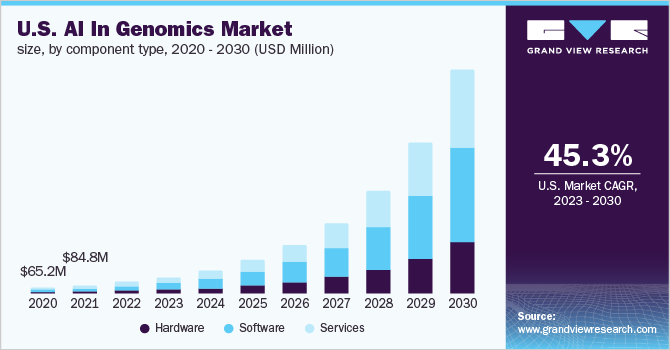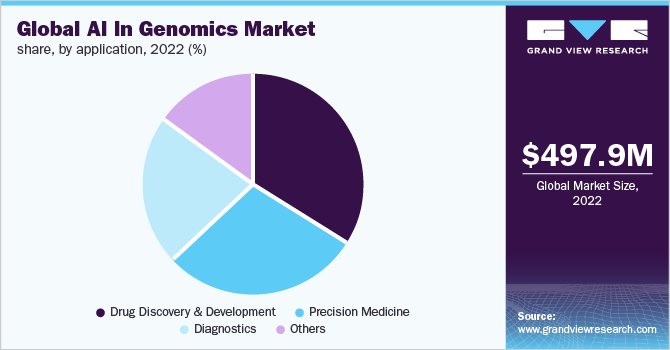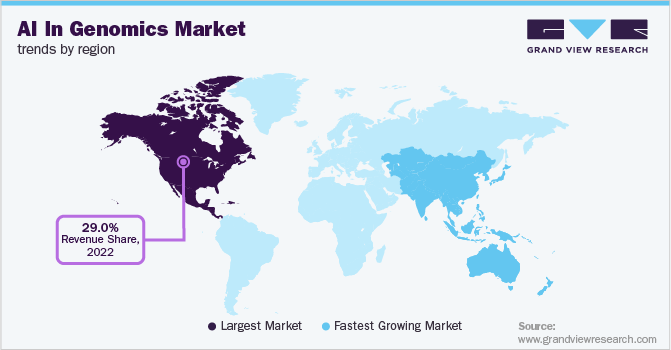- Home
- »
- Healthcare IT
- »
-
AI In Genomics Market Size & Share, Industry Report, 2030GVR Report cover
![AI In Genomics Market Size, Share & Trends Report]()
AI In Genomics Market Size, Share & Trends Analysis Report By Component (Hardware, Software), By Technology (Machine Learning), By Functionality, By Application, By End-use, By Region, And Segment Forecasts, 2023 - 2030
- Report ID: GVR-4-68040-037-9
- Number of Report Pages: 90
- Format: PDF, Horizon Databook
- Historical Range: 2018 - 2020
- Forecast Period: 2023 - 2030
- Industry: Healthcare
Report Overview
The global AI in genomics market size was valued at USD 497.9 million in 2022 and is expected to expand at a CAGR of 46.0% over the forecast period from 2023 to 2030. The rising demand for tailored medications along with the increasing R&D expenditure is driving the growth of AI in the genomics market. The key factors driving the demand for AI in the genomics industry are the rapid advancements in AI technology and its cost-effectiveness. With the rapid advancements in AI technology, new AI-powered software solutions are being developed that are specifically designed for the genomics industry. These solutions are more sophisticated and efficient, enabling researchers to analyze and manage genomic data more effectively than ever before. AI algorithms and software solutions can help automate many of the manual tasks involved in genomic research, reducing the need for human labor and making the process more cost-effective.

The COVID-19 pandemic had a positive impact on the market as it accelerated the development of computing solutions that sped up the understanding of the scope, scale, and severity of the pandemic. Key market players in the healthcare sector collaborated to create new computing solutions to develop vaccines and drugs at a significant speed. For instance, NVIDIA created new tools for genomic sequencing and artificial intelligence to aid researchers in tracking and treating COVID-19 cases. Researchers and medical professionals were able to better grasp the COVID-19 genetic variants with the use of powerful artificial intelligence (AI) tools and genome sequence analysis.
Genomics is a rapidly advancing field that is increasingly reliant on artificial intelligence. AI can identify patterns and connections in genetic data that would be difficult for humans to detect, leading to improvements in the development of new therapies for diseases, more accurate diagnoses, and personalized patient care. In addition, AI is being used to create digital models of the human body, which can be used to assess the safety and effectiveness of potential new drugs.
Component Insights
Based on components, AI in the genomics market is segmented into hardware, software, and services. In 2022, the software segment held the largest market share of around 40% and is also expected to witness the fastest CAGR of 46.6% during the forecast period. The rapid adoption of AI-based software solutions for genomics by healthcare institutions, research and development centers, and patients, and new product launches by market players are expected to drive the segments.
A range of healthcare applications, including cybersecurity, clinical trials, virtual assistants, telemedicine, and fraud detection, are increasingly using AI-based technology, which is driving the segment's fast growth. Moreover, initiatives undertaken by both the public and private sectors are contributing to market growth. In July 2018, Illumina, Inc. released an open-source AI software that can differentiate between disease-causing mutations and an individual's millions of benign genetic variants.
Technology Insights
Based on technology, the market is further segmented into machine learning and computer vision. In 2022, the machine learning segment accounted for the largest market share of around 63% and is also expected to witness the fastest CAGR over the forecast period. Machine learning has become a valuable tool in genomics research, allowing scientists to make discoveries and improve the understanding of the genetic basis of health and disease. Machine learning algorithms can automate tasks that would otherwise require significant manual efforts, such as the annotation of genomic data or the identification of potential drug targets.
The computer vision segment is likely to register a significant CAGR of over 45% during the forecast period. Computer vision, which involves the use of algorithms to analyze and interpret images, is being increasingly applied to genomics. By automating tasks and providing more accurate results, computer vision is expected to play an essential role in the advancement of genomics research.
Functionality Insights
Based on functionality, the market is segmented into genome sequencing, gene editing, and other functionalities. Among these, the genome sequencing segment dominated the market with a revenue share of 44.2% in 2022 and is anticipated to retain its dominance over the forecast period. The use of AI in genomics has sped up the process of sequencing genomes to find genetic patterns.
Genome sequencing companies are collaborating with AI technology-based companies to accelerate the procedures. For instance, in January 2022, PacBio, a provider of genome sequencing technologies collaborated with Google. Under the collaboration terms, PacBio was expected to utilize Google's algorithm development, genomic analysis, and machine learning tools to enhance PacBio's existing HiFi sequencing operations and provide new information from PacBio sequencing data.
Application Insights
Based on application, the market is further segmented into drug discovery & development, precision medicine, diagnostics, and other applications. In 2022, the drug discovery & development segment dominated the market with a revenue share of over 30%. This is attributed to an increased demand for novel medicines to treat infectious and chronic diseases, along with the expanding partnerships between pharmaceutical and biotechnology firms and market players providing AI in genomics solutions.

On the other hand, the precision medicine segment is anticipated to witness the fastest growth of over 46% during the forecast period from 2023 to 2030. AI algorithms are crucial for finding gene inheritance patterns and disease mutations. Therefore, combining genetic data with disease risk assessment supports precision medicine. Medicine development is accelerated due to the various applications of AI in genomics, reducing the time it takes for a drug to reach the market.
End-use Insights
Based on end-use, the pharmaceutical and biotech companies segment dominated the market with a revenue share of around 35% in 2022. In the biotech and pharmaceutical industry, artificial intelligence and machine learning are widely used in applications including clinical data management, automated illness prediction and prevention, and biomarker identification. AI algorithms can be used to predict the toxicity of potential drugs, which can help pharmaceutical companies avoid investing in drugs that are likely to fail in clinical trials.
The healthcare providers segment is likely to witness the fastest CAGR of 46.6% over the forecast period from 2023 to 2030. Hospitals dedicate a significant budget for research in the field of personalized medicine. In addition, the rising adoption of datasets of patient health-related digital information is expected to contribute to segment growth in the coming years.
Regional Insights
In 2022, North America held a majority of the global AI in genomics market share of around 29% in terms of revenue owing to the presence of many market players including Danone; Abbott; Nestlé; Targeted Medical Pharma, Inc.; and Mead Johnson & Company, LLC; among others. North America is home to some of the largest and most well-funded research institutions and biotechnology companies in the world, and these organizations are investing heavily in the development of AI-powered solutions for genomics. This is driving the development of new software and tools for genomic data analysis, and it is contributing to the growth of the AI in genomics market in North America.

Asia Pacific is expected to witness the fastest CAGR of 47.1% over the forecast period. The demand for AI in genomics in the region is driven by a combination of rapidly increasing healthcare expenditure, a growing focus on precision medicine, advances in genomics technology, and a large and growing population. Some Asian countries have started their national genomics initiatives, establishing their population genetic databases by sequencing the DNA of healthy people. In Thailand, a five-year Genomics Initiative worth USD 150 million was authorized by the government in 2019 to characterize the genomes of 50,000 citizens.
Key Companies & Market Share Insights
The key players in the market are undertaking various strategies including collaborations, mergers, partnerships, and acquisitions to strengthen their position in the market. Several market players are trying to position demand-friendly strategic plans into action. For instance, in May 2021, AdventHealth, a non-profit healthcare organization run by the Adventist Church, joined forces with the health intelligence firm Sema4. The partnership was expected to utilize Sema4's software and tools to merge genomic and clinical data from AdventHealth. This collaboration was expected to expand AdventHealth's focus on genomics and personalized health, which includes investment in genomics research, genetic testing, counseling, and sequencing.
In October 2020, NVIDIA announced a collaboration with an AI-powered lab for drug and vaccine innovation. The GSK center used AI technologies, biological data, and modern computer platforms, to access more precise genetic and clinical data. NVIDIA offered its expertise in GPU optimization and high-speed computational pipeline development through NVIDIA Clara discovery, a suite of optimized computational drug discovery apps and frameworks. This collaboration demonstrated how healthcare companies can leverage partnerships to advance their innovations in the field. Some of the prominent players operating in the global AI in genomics market include:
-
IBM
-
Microsoft Corporation
-
NVIDIA Corporation
-
DEEP GENOMICS
-
Data4Cure, Inc.
-
Freenome Holdings, Inc.
-
Thermo Fisher Scientific
-
Illumina, Inc.
-
SOPHiA GENETICS
-
BenevolentAI
-
Fabric Genomics
AI In Genomics Market Report Scope
Report Attribute
Details
Market size value in 2023
USD 0.71 billion
Revenue forecast in 2030
USD 9.99 billion
Growth rate
CAGR of 46.0% from 2023 to 2030
Base year for estimation
2022
Actual estimates/Historic data
2018 - 2020
Forecast period
2023 - 2030
Quantitative units
Revenue in USD & CAGR from 2023 to 2030
Report coverage
Revenue forecast, company share, competitive landscape, growth factors & trends
Segments covered
Component, technology, functionality, application, end-use, region
Regional scope
North America; Europe; Asia Pacific; Latin America; MEA
Country scope
U.S.; Canada; U.K.; Germany; France; Italy; Spain; China; Japan; India; Australia; South Korea;
Singapore; Brazil; Mexico; Argentina; Colombia; South Africa; Saudi Arabia; UAE; Israel
Key Companies Profiled
IBM; Microsoft Corporation; NVIDIA Corporation; DEEP GENOMICS; Data4Cure, Inc.; Freenome Holdings, Inc.; Thermo Fisher Scientific; Illumina, Inc.; SOPHiA GENETICS; BenevolentAI; Fabric Genomics
Customization scope
Free report customization (equivalent up to 8 analysts’ working days) with purchase. Addition or alteration to country, regional & segment scope
Pricing and purchase options
Avail customized purchase options to meet your exact research needs. Explore purchase options
Global AI In Genomics Market Segmentation
This report forecasts revenue growth and provides an analysis of the latest trends in each of the sub-segments from 2018 to 2030. For this study, Grand View Research has segmented the global AI in genomics market based on component, technology, functionality, application, end-use, and region:
-
Component Outlook (USD Million; 2018 - 2030)
-
Hardware
-
Software
-
Services
-
-
Technology Outlook (USD Million; 2018 - 2030)
-
Machine Learning
-
Deep Learning
-
Supervised Learning
-
Unsupervised Learning
-
Others
-
-
Computer Vision
-
-
Functionality Outlook (USD Million; 2018 - 2030)
-
Genome Sequencing
-
Gene Editing
-
Others
-
-
Application Outlook (USD Million; 2018 - 2030)
-
Drug Discovery & Development
-
Precision Medicine
-
Diagnostics
-
Others
-
-
End-use Outlook (USD Million; 2018 - 2030)
-
Pharmaceutical and Biotech Companies
-
Healthcare Providers
-
Research Centers
-
Others
-
-
Regional Outlook (USD Million, 2018 - 2030)
-
North America
-
U.S.
-
Canada
-
-
Europe
-
U.K.
-
Germany
-
France
-
Italy
-
Spain
-
-
Asia Pacific
-
Japan
-
China
-
India
-
Australia
-
South Korea
-
Singapore
-
-
Latin America
-
Brazil
-
Mexico
-
Argentina
-
Columbia
-
-
Middle East & Africa
-
South Africa
-
Saudi Arabia
-
UAE
-
Israel
-
-
Frequently Asked Questions About This Report
b. The global AI in genomics market size was estimated at USD 497.9 million in 2022 and is expected to reach USD 0.71 billion in 2023.
b. The global AI in genomics market is expected to grow at a compound annual growth rate of 46.0% from 2023 to 2030 to reach USD 9.99 billion by 2030.
b. In 2022, North America dominated the market in terms of revenue share of around 29%. North America is home to some of the world's largest and most well-funded research institutions and biotechnology companies, and these organizations are investing heavily in the development of AI-powered solutions for genomics. This is driving the development of new software and tools for genomic data analysis, and it is contributing to the growth of the AI in genomics market in North America.
b. Some of the key market players operating in the AI in genomics market are NVIDIA Corporation; Microsoft; IBM; BenevolentAI; Thermo Fisher Scientific; Illumina, Inc; Fabric Genomics; Freenome Holdings, Inc; among others.
b. The rising R&D spending and growing demand for tailored medications are driving AI in the genomics market. Collaborations among key companies are further fostering the market's expansion. Other factors driving the demand for AI in the genomics industry are the rapid advancements in AI technology and its cost-effectiveness. With the rapid advancements in AI technology, new AI-powered software solutions are being developed that are specifically designed for the genomics industry. These solutions are more sophisticated and efficient, enabling researchers to analyze and manage genomic data more effectively than ever before. AI algorithms and software solutions can help to automate many of the manual tasks involved in genomic research, reducing the need for human labor and making the process more cost-effective.
Share this report with your colleague or friend.
![gvr icn]()
NEED A CUSTOM REPORT?
We can customize every report - free of charge - including purchasing stand-alone sections or country-level reports, as well as offer affordable discounts for start-ups & universities. Contact us now
![Certified Icon]()
We are GDPR and CCPA compliant! Your transaction & personal information is safe and secure. For more details, please read our privacy policy.
We are committed towards customer satisfaction, and quality service.
"The quality of research they have done for us has been excellent."





